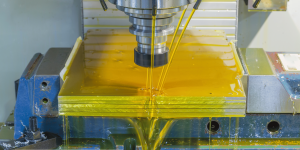CNC machining is a manufacturing process in which metals and other materials are shaped by computer-controlled machine tools. Cutting fluid or coolant plays a crucial role in the CNC machining process and is an integral part of the entire process. Coolants play several vital roles, such as cooling both the tool and workpiece, washing away the chips, and protecting against the formation of rust. In this article, you will find information on various types of CNC coolants and how to choose the best one for your needs.
Types of CNC Coolants
There are several major categories of coolants used in CNC applications:
Water-Soluble Oils
– Are compounds that comprise of mineral oil which has been emulsified with other ingredients to enable the preparation of an aqueous solution.
– Both cooling and lubrication should be provided
– Coolant most commonly used in CNC
– Concentration is usually 5-10% oil and the balance water.

Synthetic Fluids
– Developed from chemical constituents and not petroleum oils
– Provide better cooling efficiency as compared to soluble oils
– Suitable for usage in high-speed machining operations
– It is generally characterized by its clear or, at least, semi-transparent nature.
Neat Oils
– Oils that are not mixed with water
– Aids in the generation of good lubricity that is suitable for low-speed usage.
– It can work on materials that are difficult to machine.
– Need extra filtration equipment and additional recycling equipment
Gaseous Coolants
– Use air or an inert gas such as nitrogen or argon
– There is no fluid to manipulate and recycle through a circuit.
– Little cooling effect but provides chip control
– It is usually used when the least coolant is needed.
Factors to Consider
There are several important factors to weigh when selecting a CNC coolant:
Machining Application
– High-speed machining requires the highest form of cooling.
– Low-speed operations call for frequent lubrication
– Choice of coolant depends on the type of material being machined
Environmental Considerations
– Water-soluble oils are less challenging to filter and be recycled.
– Synthetic fluids that are said to have less impact on the environment
– Disposal must be made according to the hazardous waste rules
Machine Compatibility
– Look at the machine manual to determine the recommended coolant.
– Take some factors into consideration such as capacity of the pump, need for filtration, and size of the reservoir.
Cost Analysis
– Initially, the cost of the product versus its ‘life expectancy.’
– Think about the concentration required and dilution rates
– Another consideration is the cost of disposing of the fluids at the end of their useful life.
Health and Safety Issues
– This means that prolonged radiation exposure can cause skin disorders.
– While synthetic fluids were said to be less irritating to the linings of the stomach and intestines.
– Periodic checkups and correct utilization of personal protective gear are critical.
As many coolant brands and types are available in the market today, it is beneficial to study the particularities of the application and have a clear vision of essential fluid characteristics before making a decision. It is advisable to consult a professional coolant supplier to examine the requirements for operation when selecting a CNC coolant.
To minimize the risks, proper care and handling of CNC coolants should be observed strictly in the following ways:
To utilize a CNC coolant to the maximum and get the best of it upto the time it is usable, it is essential to take good care of it.
Here are some best practices:
Filtration
– They eliminate dirt, metal fines, and bacteria from the system
– It is crucial to maintain the integrity of the fluid and its ability to go through additional cycles.
– They can utilize filters, centrifuges, and magnetic separators.
Concentration Control
– Use the refractometer to ensure the concentration and add more if required.
– A significant factor for water-soluble oils – do not let them become too diluted.
Regular Testing
– This is done by checking the pH, bacteria, and the tendency to rust.
– Prevent problems before they arise by recognizing them at an early stage
– Most tests that can be performed in the shop are relatively straightforward.
Fluid Recycling
– To operate the desired components of the machining process, such as skimmers, chip conveyors, and coolant recyclers.
– Remains as coolant in the machine rather than turning into waste.
Avoid Contamination
– Do not allow hydraulic oils, neat oils to come in contact with coolant.
– Any leakage in a machine should be fixed as soon as possible
Through accurate observation of the coolant condition as well as taking adequate precautions, shops can enhance the useful life of the coolant, lower consumption and in turn minimize on the costs of disposing the coolant.
Selecting the Best CNC Coolant Company
Choosing the right CNC coolant supplier is crucial in achieving the desired fluid performance and service time.

Some things to look for include:
Technical Expertise
– Machining process acquainted sales engineers
– Provide training on care, testing, and recycling of fluids
Fluid Analysis Services
– Perform periodic sample trials and provide recommendations
– Detect problems before they lead to a failure
Custom Formulation
– Customize coolant to the exact requirements of the specific shop and application
– Integrate the best features into a single product
Local Support
– Ensure that the supply of products is made available in the shortest time possible
– Continued support: offer assistance with maintenance and troubleshooting
Value Added Services
– Help with coolant conversions, machine installs
– Discharge waste coolant by the requirements of the law
Thus, by integrating supplier knowledge, custom fluids, and services, shops can achieve significant advances in CNC machining outcomes.
Conclusion
CNC coolants are critical in determining the quality of the final part, longevity of the cutting tools, useful life of the fluid and efficiency of the machining process. There are many different types of fluids that can be used and these include machine compatibility, environmental/health concerns and cost. It is also essential to continuously check the coolant condition and avoid contamination. Working with a professional coolant supplier enables one to meet the needs of the shops in question. Taking the time to select the most appropriate coolant and maintenance regime will prove to be highly cost-effective in the longer term.
